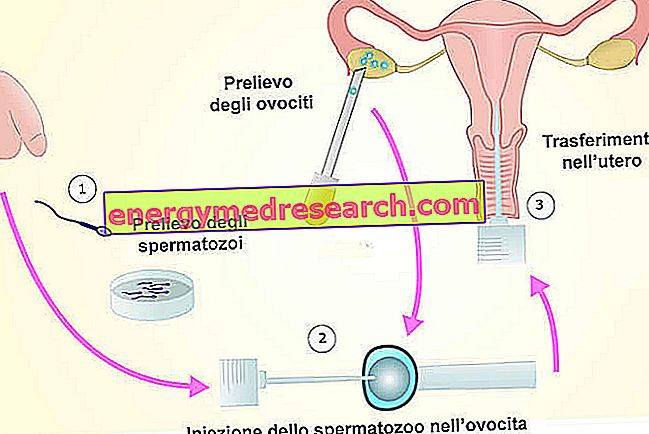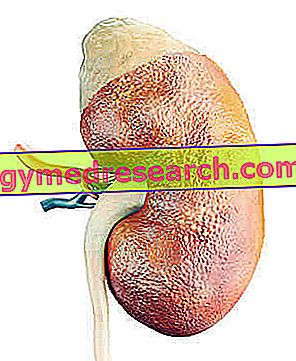Generality
ICSI (intracytoplasmic sperm injection) is a medically assisted procreation (PMA) technique that involves inseminating an oocyte by micro-injecting a single sperm directly into it.

In this practice, the gametes (oocyte and spermatozoon) meet outside the woman's body, so fertilization and the formation of one or more embryos take place "in a test tube" (more precisely, on a culture plate), rather than all inside the fallopian tube of the patient.
Subsequently, the embryos are transferred to the uterus, where the implant takes place, which can result in pregnancy.
- The ICSI method generally involves the pharmacological stimulation of the ovary to produce more oocytes, followed by surgical removal of the same (this is a small intervention called a pick-up ); the collection of male gametes can be performed, instead, by masturbation, percutaneously or testicular biopsy.
In the laboratory, the female gametes taken are placed on culture plates inside incubators, then the individual spermatozoa are inoculated with a micropipette directly into the oocyte cytoplasm.
If the oocytes are successfully fertilized, the embryos are transferred into the uterus by transvaginal, ultrasound-guided or hysteroscopic treatment, within 48-72 hours.
Recourse to the ICSI is expected only after the PMA center doctor has ruled out the possibility of natural conception. This technique is indicated, in particular, in cases where severe male infertility is present; in fact, ICSI makes it possible to overcome the difficulties of fertilization, since a single spermatozoon is inserted directly into the oocyte cytoplasm.
Introductory notes
- Medically assisted procreation (PMA) helps couples who wish to have a child, but cannot spontaneously undertake a pregnancy. This option is indicated by doctors as part of a treatment pathway, in cases where infertility of at least one of the two partners is found and there are no other effective therapeutic methods to resolve this condition.
- The World Health Organization (WHO) defines infertility as "failure to conceive in a couple after 12-24 months of unprotected targeted relationships " (that is, that is, during the days of probable ovulation).
- Assisted fertilization uses various simple or complex techniques, involving the manipulation of female gametes (oocytes), male (spermatozoa) or embryos. The first level methods include hormonal stimulation, ultrasound monitoring of women's ovulation and intrauterine insemination (IUI); the latter is characterized by the fact that fertilization takes place directly within the female genital apparatus. The second and third level complex treatments, on the other hand, require that fertilization first take place in vitro and include: IVF (in vitro fertilization with embryo transfer), ICSI and GIFT (intratubarial transfer of gametes). These procedures are indicated when the infertility to be addressed is serious and requires more invasive methods, which require local anesthesia and / or deep sedation.
Indications
The causes that can determine infertility are many and can depend on just one or both partners.
Usually, the ICSI technique is recommended in cases of:
- Tubal factors : the fallopian tubes (the two channels that connect the ovaries to the uterus) can be obstructed or damaged for various reasons; this hinders the conception (that is the meeting of the seminal fluid with the egg cell) or the descent of the fertilized egg into the uterus for the implant. Tubal lesions often depend on neglected sexual infections (such as, for example, chlamydia), but can also derive from congenital diseases, pelvic surgery or previous ectopic pregnancy .
- Male infertility of severe grade : it can result from various conditions that compromise the production or quality of the seminal fluid, such as varicocele (varicose dilation of the veins of the scrotum), cryptorchidism (failure or incomplete descent of the testicles in the scrotal sac) and hormonal deficits (eg hypogonadotropic hypogonadism). Other causes may include: chronic infections that cause abnormal seminal fluid or cause partial or total closure of the vas deferens, genetic abnormalities and immunological factors (production of anti-sperm antibodies by the male organism or partner).
- Failure of the therapeutic procedure of first-level techniques, ie when medical-surgical treatment or intrauterine inseminations have not given results;
- Missed or reduced fertilization in previous IVF cycles (IVF).
Other conditions that make ICSI necessary include:
- Unexplained sterility (that is to say, you cannot ascertain an ascertained cause), if the previous treatment (eg insemination cycles) has not given results or has been judged inappropriate;
- Obstructive azoospermia (absence of spermatozoa in the seminal fluid, due to obstructions that prevent its emission with ejaculation) and secretion (lack of sperm production in the testicles);
- Reduced ovarian reserve : low number of oocytes in the ovaries due to the advancement of the woman's age or due to congenital or surgical causes;
- Endocrine-ovulatory infertility : the ovaries do not produce oocytes due to causes of hormonal origin;
- Endometriosis : abnormal growth of tissue similar to that which normally covers the inside of the uterus (endometrium) in other sites; this condition can cause infertility as it often produces adhesions to the ovaries or fallopian tubes.
- Factors of infertility both male and female : there are simultaneously several causes that influence conception.
Preliminary medical investigations
When a couple fails to procreate despite targeted sexual intercourse, over a period of 12-24 months, medical investigations may be indicated aimed at verifying the infertility of at least one of the partners.
First of all, the doctor meets the two patients and draws up a medical history based on their medical history, then establishes whether there are factors that affect fertility (eg, sexual infections, excessive obesity or thinness, anti-tumor treatment, smoking, alcohol abuse). etc.) and recommends the most appropriate therapeutic procedure for solving the reproductive problem.
If the conditions encountered cannot be managed with other adequate pharmacological and / or surgical interventions, then if procreation is impossible or in any case the probability of beginning a pregnancy is remote (as in the case, for example, of tubes that are not visible or damaged, sperm with deficit values etc.), doctors indicate the use of medically assisted procreation. The procedure adopted is usually chosen based on the infertility cause presented by the couple.
Diagnostic pathway to ascertain infertility
Depending on the profile of the couple, the PMA center specialist can recommend specific tests to rule out the presence of hormonal dysfunctions, pathologies affecting the uterus and tubes, abnormalities of the seminal fluid and so on.
For the couple
- Hormonal dosages (we evaluate the levels of sex hormones present in the blood, to exclude dysfunctions);
- Genetic investigations (to assess possible anomalies);
- Immunological tests for the presence of anti-sperm antibodies.
For man
- Spermiogramma (examination of the seminal fluid to assess its fertilizing capacity and other fundamental functions, such as the number, morphology and percentage of motile spermatozoa);
- Spermioculture (sperm analysis to assess the presence of infectious agents in the genital organs).
For the woman
- Hysterosalpingography (to check the state of the tubes and their patency);
- Ultrasound of the uterus and ovaries (it allows to control ovulation, the quantity of oocytes, the presence of possible cysts, fibroids or other formations);
- Hysteroscopy (endoscopic examination of the uterine cavity);
- Pap test (cytological examination that investigates the presence of an HPV lesion and the alterations of the cells at the level of the cervix);
- Search for infectious agents (eg vaginal swab for the detection of common pathogens such as Chlamydia and Candida ).
How is it done?
The ICSI method is used together with IVF, with the difference that the fertilization method of the oocyte takes place with the injection of a single spermatozoon into the cytoplasm.
Also in this case, therefore, the meeting of the gametes takes place outside the woman's body (ie on a culture plate). After the successful fertilization, the embryos are then transferred to the uterus.
Obtaining oocytes
ICSI can be performed:
- In a spontaneous cycle (therefore without any ovarian stimulation therapy);
- With pharmacological stimulation of ovulation to cause more oocytes to mature, ie with the induction of follicular growth with the simultaneous production of more female gametes by administering drugs (daily dosages).
In the latter case, the ovarian response is checked by:
- Ultrasound monitoring : a series of ultrasound scans are performed, approximately every two days, to observe the growth of the follicles, from which the oocytes will derive;
- Hormonal dosage : blood samples are taken to assess the secretion of hormones associated with the growth of follicles in the ovary.
Surgical sampling of oocytes produced and collection of sperm
After stimulating the ovary to produce more follicles, oocyte collection (pick-up) is performed with a transvaginal procedure, under local anesthesia and / or deep sedation. Under ultrasound control, the follicles are "points" with a needle and the egg is sucked into them. In the ICSI technique, the puncture and aspiration procedure lasts on average from 5 to 15 minutes, depending on the number of follicles present.
Sperm is collected by masturbation after 2–3 days of ejaculatory abstinence, on the same day as egg retrieval. In some cases, the collection of male gametes is performed percutaneously or testicular biopsy.
Fertilization of the collected oocytes takes place on the same day of collection.
Fertilization of oocytes in the laboratory
The follicular liquid is analyzed under a microscope to isolate the oocytes, which are transferred into a special culture liquid and stored in an incubator. At the same time, the semen sample is prepared, with selection of the mobile and vital spermatozoa.
Then proceed to the union and extracorporeal cultivation of gametes. The ICSI technique is based on a principle of "imitation" of the fertilization process, by manipulation under microscopic guidance: the oocyte is held in place with a glass pipette and with the help of a needle cannula is injected into the cytoplasm a single spermatozoon.
The product of this operation is placed on special plates with culture media that give nutrition to the cells, inside incubators. This phase is very delicate and takes place under the strict control of biologists and embryologists, who monitor all the processes of cell division that will lead to the formation of the embryo.
As for IVF, 16-18 hours after insemination, fertilization occurs, ie the formation of the zygote, where the two pronuclei (male and female) can be observed.
Embryo development and transfer to the uterus
After 48-72 hours, 1 to 3 embryos are selected and they are transferred to the uterus. The sample is introduced into a thin plastic catheter and channeled by the gynecologist to the end of the uterus. The introduction of embryos lasts only a few minutes and is generally painless.
Cryopreservation
Within the limits of the regulations in force, the non-transferred embryos are frozen in liquid nitrogen, therefore they are stored in the sample bank. The ICSI technique can, in fact, foresee the use of gametes or newly fertilized embryos (" fresh cycles ") or cryopreserved, that is brought and maintained at very low temperatures (" thawing cycles ").
If the pregnancy is not reached at the first attempt, the embryos or oocytes previously cryopreserved can be used for subsequent treatment cycles.
Success rate
The ICSI technique is associated with a high percentage of fertilization with embryo formation (spermatozoon is spared from crossing the pellucid membrane) and has good success in the presence of severe male infertility. In the case of azoospermia, in fact, the technique can be performed using the gametes present in the testicles or in the epididymis, from where they are taken by aspiration or microsurgery (similar to a biopsy). The only condition necessary for ICSI application is, in fact, that the spermatozoa are vital.
The pregnancy success rate is also good (generally speaking, it is estimated to be around 20% per cycle). The outcome of the treatment depends on the quality of the embryos transferred in vitro and on the capacity of the uterus to receive them.
Risks and possible complications
- The response to various therapeutic protocols to induce ovulation must be controlled (with ultrasound scans of the ovaries and / or hormonal dosages) to avoid ovarian hyperstimulation syndrome, that is, excessive follicular maturation and egg production.
This condition can involve various symptoms, such as shortness of breath, nausea and enlargement of the ovaries, which are painful, causing discomfort in the patient; in the most serious cases, abdominal distention and the formation of blood clots can occur which could make hospitalization necessary.
- Peritoneal infections are one of the possible consequences of the laparoscopic procedures associated with the ICSI technique, aimed at finding the egg cells.
- Furthermore, it is necessary to report a greater probability of multiple pregnancies, since in order to increase the possibility of giving rise to a conception, during the ICSI procedure, several embryos can be transferred inside the uterus. A multiple pregnancy carries risks to the health of the mother and children, who are more likely to be born prematurely and to be underweight at the end of gestation.



